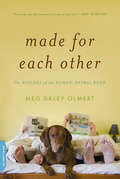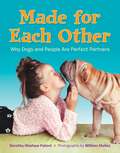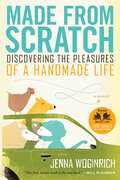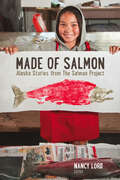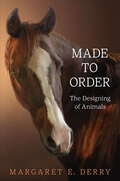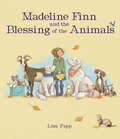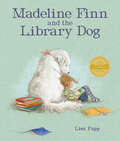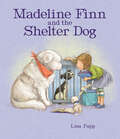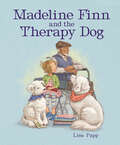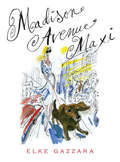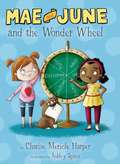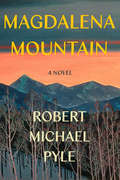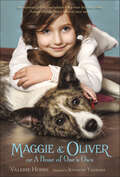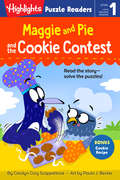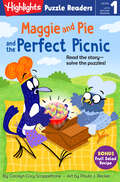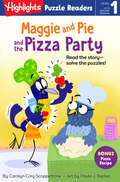- Table View
- List View
Made for Each Other: The Biology of the Human-animal Bond
by Meg Daley OlmertOxytocin is a hormone that has been implicated in romantic and maternal love. As a producer of nature documentaries for television who participated in research on the neurobiology of social bonding, Olmert examines the evidence for oxytocin as also being the basis for the evolution of the human-animal bond. Her interesting, general audience treatment concludes by noting the facilitators and barriers modern society poses for this relationship. Annotation ©2009 Book News, Inc., Portland, OR (booknews.com)
Made for Each Other: The Biology of the Human-animal Bond
by Meg Daley OlmertOxytocin is a hormone that has been implicated in romantic and maternal love. As a producer of nature documentaries for television who participated in research on the neurobiology of social bonding, Olmert examines the evidence for oxytocin as also being the basis for the evolution of the human-animal bond. Her interesting, general audience treatment concludes by noting the facilitators and barriers modern society poses for this relationship. Annotation ©2009 Book News, Inc. , Portland, OR (booknews. com)
Made for Each Other: Why Dogs and People Are Perfect Partners
by Dorothy Hinshaw Patent William MunozDog lovers everywhere will enjoy this insightful, adorable, and fact-filled photographic picture-book exploration of why dogs really are a man's best friend.It's no secret that people and pups are best friends. But did you know that this special bond dates back tens of thousands of years? During that time, we have only grown closer. Now cutting-edge science is helping us learn why we're so perfect together. Brain-imaging machines show how simply seeing you makes your dog's brain light up in its reward center. And blood samples reveal how just a touch or a gaze between two devoted friends releases helpful hormones that de-stress both pooch and person. In fact, we really speak each other's language--using pointing, barking, touch, and body movement.Dogs make our lives better in so many ways. They keep us safe, rescue us in disasters, and guide us when we can't see. But a dog's most important job is to be its person's best friend. And as we learn more about the similarities of people and our four-legged friends, it's clear we are truly made for each other."By the time you finish this book, you're ready to add a dog to your family." --Huffington Post
Made from Scratch: Discovering the Pleasures of a Handmade Life
by Jenna WoginrichIn a hectic world of mass-produced food, clothing, and entertainment, it’s easy to miss out on the simple pleasures of doing things for yourself. Young web designer Jenna Woginrich chronicles her adventures as she learns to embrace the idea of self-sufficiency in all aspects of her life, including sewing her own clothes, growing her own food, and creating her own fun outside of the mainstream. Woginrich’s hilarious, heartbreaking, and soul-satisfying journey will bring joy and inspiration to those who dream about a more independent lifestyle.
Made of Salmon: Alaska Stories from the Salmon Project
by Nancy LordAll over the world, salmon populations are in trouble, as overfishing and habitat loss have combined to put the once-great Atlantic and Pacific Northwest runs at serious risk. Alaska, however, stands out as a rare success story: its salmon populations remain strong and healthy, the result of years of careful management and conservation programs that are rooted in a shared understanding of the importance of the fish to the life, culture, and history of the state. Made of Salmon brings together more than fifty diverse Alaska voices to celebrate the salmon and its place in Alaska life. A mix of words and images, the book interweaves longer works by some of Alaska’s finest writers with shorter, more anecdotal accounts and stunning photographs of Alaskans fishing for, catching, preserving, and eating salmon throughout the state. A love letter to a fish that has been central to Alaska life for centuries, Made of Salmon is a reminder of the stakes of this great, ongoing conservation battle.
Made to Order: The Designing of Animals
by Margaret E. DerryAnimal breeding has been complicated by persisting factors across species, cultures, geography, and time. In Made to Order, Margaret E. Derry explains these factors and other breeding concerns in relation to both animals and society in North America and Europe over the past three centuries. Made to Order addresses how breeding methodology evolved, what characterized the aims of breeding, and the way structures were put in place to regulate the occupation. Illustrated by case studies on important farm animals and companion species, the book presents a synthetic overview of livestock breeding as a whole. It gives considerable emphasis to genetics and animal breeding in the post-1960 period, the relationship between environmental and improvement breeding, and regulation of breeding as seen through pedigrees. In doing so, Made to Order shows how studying the ancient human practice of animal breeding can illuminate the ways in which human thinking, theorizing, and evolving characterize our interactions with all-natural processes.
Madeline Finn and the Blessing of the Animals
by Lisa PappWhen Madeline Finn attends the Blessing of the Animals with Bonnie and Star, she learns that everyone has a gift inside, which they can share with the world. And one way that Madeline Finn can share her blessing is with the animals at her local shelter.It&’s a special day! Madeline Finn is taking Bonnie and Star to the Blessing of the Animals. When they arrive, they see dogs and cats. There&’s even a goat!Madeline Finn watches closely as the Reverend Mary Alice spends time with every animal, giving each one their very own blessing.&“How do you know what to say?&” Madeline Finn wants to know.&“Everyone has a blessing inside,&” Miss Mary explains. &“A special gift to share with the world.&”When Madeline Finn receives a blessing all her own, she has a new mission: finding the blessings in others. Surely, the furry and feathery residents at her local animal shelter have lots of special gifts to share. They just need someone to believe in them—someone to set those blessings free.
Madeline Finn and the Library Dog
by Lisa PappA delightfully warm, encouraging story of a young girl and the special library dog who helps her develop patience, acceptance, and confidence as she learns to read, from award-winning author-illustrator Lisa Papp.Madeline Finn does NOT like to read. But she DOES want a gold star from her teacher. Except stars are for good readers, for understanding words, and for saying them out loud—things that Madeline Finn doesn't believe she can do.Fortunately, Madeline Finn finds a little help when she meets Bonnie, a library dog. Reading out loud to Bonnie isn't so bad, and when Madeline Finn gets stuck, Bonnie doesn't mind. As it turns out, it's fun to read when you're not afraid of making mistakes. Bonnie teaches Madeline Finn that it's okay to go slow—and, most importantly, to keep trying.Lisa Papp offers an inspiring and comforting story, perfect for new readers who just need a little confidence to overcome their fears.
Madeline Finn and the Shelter Dog
by Lisa PappMadeline Finn finds a new way to help more dogs and read more stories, in this latest book from award-winning author-illustrator Lisa Papp.After Madeline Finn meets library dog Bonnie, she asks her mother for a puppy of her own every single day. Finally, Mom says yes, and Madeline Finn chooses Star, one of Bonnie's puppies.Then Bonnie's owner, Mrs. Dimple, tells Madeline Finn about animal shelters―places many other pets come from. A visit to their local shelter leads Madeline Finn to ask some questions. Does anyone play with the shelter dogs, or snuggle with them, or read to them? Questions lead to answers, and ideas, and soon Madeline Finn and her human and animal community discover there are lots of ways for small people to make a big difference.Award-winning author-illustrator Lisa Papp offers a kind, empathetic exploration of life in an animal shelter in this perfect story for dog lovers, pet adoption and rescue advocates, and young readers learning how to make a difference through community service.
Madeline Finn and the Therapy Dog
by Lisa PappMadeline Finn is training her dog Star to become a therapy dog. Will they pass the test? A beautiful story of empathy, perseverance, and community from Lisa Papp.Madeline Finn and Star are off to Walker Oaks, a retirement community where Star will take his tests to become a therapy dog. Accompanied by Mom, Mrs. Dimple, and Bonnie the library dog, Madeline and Star make their way through a variety of challenges and meet several new friends. But Madeline Finn can't stop thinking about an elderly man in a wheelchair who never smiles. Is there something she and Star can do to help?Author-illustrator Lisa Papp's empathetic, feel-good story explores the therapy dog training process and provides a realistic and appealing example of a young person making a difference. Paired with warm, gentle illustrations, this book is ideal for social emotional learning and discussions about self-esteem, volunteering, community, and—of course—therapy animals.
Madison Avenue Maxi
by Elke GazzaraWhen Ben Gazzara and his wife, Elke, reluctantly agree to adopt the pet dachshund their daughter no longer wants, the couple unknowingly takes a new member into their family. Neither of the Gazzaras is a "dog person," and the sudden presence of a pet in the lives of these jet-setters appears at first uncertain. However, the ever-sweet, playful, and surprisingly smart Maxi immediately endears herself, and soon she becomes the Gazzaras' unlikely "child" in the empty nest of their Madison Avenue townhouse. The little dog accompanies the pair everywhere - to the theater, restaurants, dinner parties, world-class hotels, receptions for heads of state, and even the dentist. Madison Avenue Maxi is the story of a love affair between a dog and her owners. With heartfelt humor and a dog lover's eye, Gazzara chornicles Maxi's antics in Manhattan as well as at their second home in Tuscany and over travels to the French Riviera, Brazil, Spain, and other luxurious locales. Along the way she meets celebrities such as Roman Polanski, Gena Rowlands, John Voigt, Danielle Steele, Gay Talese, Peter Bogdanovich, New York's mayor Michael Bloomberg, and Frank Gehry. Madison Avenue Maxi is a warm, touching memoir of man - and woman's-best friend.
Madison's New Buddy (American Girl: Forever Friends #2)
by Crystal VelasquezThe Kew Gardens animal shelter is starting a new project where they invite local school classes into the shelter to read to the dogs and cats. Being read to helps the animals feel calmer, which means they can be adopted faster. Madison is eager to help. There's just one problem. She's not a very strong reader, and she doesn't want her new classmates to find out-not even Jasmine, Keiko, or Sofia. When a very nervous dog arrives at the shelter, Madison worries that he won't get adopted. If reading aloud to him might help, than Madison is going to try-even if it means letting her friends in on her secret.
Mae and June and the Wonder Wheel
by Charise Mericle Harper Ashley SpiresIn this chapter book for young readers, June is thrilled to get a new neighbor: Mae! Soon the two of them are best friends and are having adventures determined by the Wonder Wheel that they spin each morning. Whether it’s pretending to be a dog for a day or collecting things that are blue, the girls never know what each day will bring. Also, June has a secret: her dog Sammy can talk, but only she can hear him. Will her new best friend believe her if she tells her?
Magdalena Mountain: A Novel
by Robert Michael Pyle"An elegant, eccentric novel of love, loneliness, and lepidoptera . . . Worthy company for work by other naturalist/novelists: Nabokov, Matthiessen, Kingsolver." —Kirkus ReviewsIn Magdalena Mountain, Robert Michael Pyle's first and long–awaited novel, the award–winning naturalist proves he is as at home in an imagined landscape as he is in the natural one. At the center of this story of majesty and high mountain magic are three Magdalenas—Mary, a woman whose uncertain journey opens the book; Magdalena Mountain, shrouded in mystery and menace; and the all–black Magdalena alpine butterfly, the most elusive of several rare and beautiful species found on the mountain. And high in the Colorado Rocky Mountain wilderness, sharing the remote territory of the Erebia magdalena butterfly, lives the enigmatic Oberon, a reluctant de facto leader of the Grove, a diverse community of monks who share a devotion to nature. Converging in the same wilderness are October Carson, a beachcomber–wanderer in pursuit of the alpine butterflies he collects for museums; James Mead, a young graduate student intent upon learning the ecology of this seductive creature; and Mary Glanville, who also seeks the butterfly but can't remember why. While the mystery surrounding Mary takes a menacing turn, their shared quest pulls them deeper into the high mountain wilderness, culminating in a harrowing encounter on the stony slopes of Magdalena Mountain.
Maggi and Milo
by Juli BrenningMaggi is an excellent adventurer, a pretty good songwriter, an aspiring scientist, and Milo's best friend. Milo is a Border Collie, and he's very smart. When Maggi gets a book about frogs from her grandma, naturally, she decides to take Milo to find frogs the very next day. But it turns out that catching frogs is hard work. Lucky for Maggi, Milo is there to help. And lucky for Milo, even though Maggi’s not the world’s best frog hunter, she’s the kind of friend who makes everything a little more fun.With the spunk of Ladybug Girl and an illustration style suggestive of Charles Schulz, Maggi and Milo are an irresistible pair with a whole lot of charm.
Maggi and Milo Make New Friends
by Juli BrenningPerfect for fans of Ladybug Girl, this playground adventure about the joy of making new friends continues the story of the plucky girl-and-dog duo from Maggi and Milo Maggi is an irrepressible girl with an equally awesome best friend: her dog, Milo. So when Mom suggests a day at the park with other kids, Maggi isn't sure. All she needs is Milo, afer all. But off to the playground they go—only to find that no dogs are allowed! Maggi wants to stay behind, but the other kids are having so much fun that . . . she decides to go in. Before long, she has a whole group of new friends, and all of them want to try walking Milo. But first, they have to find a family of rollie-pollies, complete a treasure hunt, and build a pirate ship. When it's time to go, Maggi waves goodbye to her new friends—but she knows she's going home with Milo, her best friend of all. With bright, playful, Charles Schulz-style illustrations and a distinctive real-kid voice, this endearing picture book series introduces kids to a sweet girl-and-dog friendship that full of adventure.
Maggie & Oliver, or A Bone of One's Own
by Valerie HobbsMaggie is always full of questions. But a young maid in a fine lady's house isn't supposed to wonder so much, so one day Maggie is thrown out into the street with only a tiny heart-shaped locket for a keepsake. Who is the lady in the locket?A little dog named Oliver is pushing his nose along an icy sidewalk searching for his lost mistress, or at least something to eat. No matter how hard he looks he can't find either one, but he does see a girl with round blue eyes and a golden locket around her neck. The girl calls him "Lucky."And perhaps Lucky is the right name after all, for the little dog soon helps Maggie find a warm, wonderful home of her own—and one for him, too.
Maggie By My Side
by Beverly ButlerWhen cancer unexpectedly struck down Beverly Butler's guide dog, Una, it hurt to imagine another dog taking her place. Yet it was because of what Una and three other dedicated dogs before her had given her in terms of independence and dignity that made getting a new dog as certain as sunrise. In Maggie By My Side, she tells of the challenges, hazards, and joys of training with Maggie, her fifth guide dog since losing her sight at fourteen. It is also an account of the foibles, quirks, and devotion of the guide dogs who preceded Maggie. Part of the story is poignant--the anguish of Una's death--and part is hilarious--Maggie's introduction to the family cats. In this lively narrative we learn the history of guide dogs, what it takes to become a trainer, how new guide dogs come to be, and share in the vivid firsthand experiences that bring it all to life. This is a Junior Literary Guild selection, chosen as an outstanding book for boys and girls (A Group). Pictures are described.
Maggie The One-Eyed Peregrine Falcon: A True Story Of Rescue And Rehabilitation (Wildlife Rescue Stories Ser.)
by Christie Gove-BergMaggie has just learned to fly when she crashes into the side of a building. She falls to the ground, alone and injured. Who will help her? As told with real photographs, this true story explains how wildlife hospitals rescue and treat injured animals. Their goal is to release the animals back into the wild. Sometimes, this isn't possible but there can still be a happy ending. Maggie's story, a Mom's Choice Awards Gold Recipient, is just such a success.
Maggie and Max (The Puppy Place #10)
by Ellen MilesCharles and Lizzie have helped lots of puppies find homes. But then they meet a Saint Bernard puppy with an unusual friend: a helpless kitten! And this pair needs to stick together. Will Charles and Lizzie find a way to keep these two together forever?
Maggie and Pie and the Big Breakfast (Highlights Puzzle Readers)
by Carolyn Cory ScoppettoneHighlights Puzzle Readers offer an innovative approach to learning that integrates puzzles and stories to develop motivated, confident readers. These Level 1 books are perfect for kids who are reading simple sight words and sounding out decodable text.Fans of Amelia Bedelia will love these bird buddies! Maggie, a scatter-brained magpie, and Pie, a rule-following pigeon, love to cook together, but sometimes Maggie gets a little mixed up! In this Level 1 Highlights Puzzle Reader, kids solve visual logic puzzles to help find the right ingredients. With a bonus recipe so kids can make their own applesauce pancakes, Maggie and Pie and the Big Breakfast is perfect for beginning readers.
Maggie and Pie and the Cookie Contest (Highlights Puzzle Readers)
by Carolyn Cory ScoppettoneHighlights Puzzle Readers offer an innovative approach to learning that integrates puzzles and stories to develop motivated, confident readers. These Level 1 books are perfect for kids who are reading simple sight words and sounding out decodable text.Maggie and Pie are bird buddies that love to cook—but sometimes Maggie gets a little mixed up! As they bake cookies in this Level 1 Highlights Puzzle Reader, kids can use clues in the story to find the supplies they need in simple visual puzzles that double as picture support for the text. With a bonus recipe, Maggie and Pie and the Cookie Contest will appeal to junior chefs who are just discovering reading.
Maggie and Pie and the Perfect Picnic (Highlights Puzzle Readers)
by Carolyn Cory ScoppettoneHighlights Puzzle Readers offer an innovative approach to learning that integrates puzzles and stories to develop motivated, confident readers. These Level 1 books are perfect for kids who are reading simple sight words and sounding out decodable text.Maggie and Pie are bird buddies that love to cook—but sometimes Maggie gets a little mixed up! As they make fruit salad, in this Level 1 Highlights Puzzle Reader, kids can use clues in the story to find the supplies they need in simple visual puzzles that double as picture support for the text. With a bonus recipe, Maggie and Pie and the Perfect Picnic will appeal to junior chefs who are just discovering reading.
Maggie and Pie and the Pizza Party (Highlights Puzzle Readers)
by Carolyn Cory ScoppettoneHighlights Puzzle Readers offer an innovative approach to learning that integrates puzzles and stories to develop motivated, confident readers. These Level 1 books are perfect for kids who are reading simple sight words and sounding out decodable text.Fans of Amelia Bedelia will love these bird buddies! Maggie, a scatter-brained magpie, and Pie, a rule-following pigeon, love to cook together, but sometimes Maggie gets a little mixed up! In this Level 1 Highlights Puzzle Reader, kids solve visual logic puzzles to help find the right ingredients. With a bonus recipe so kids can make their own pizza, Maggie and Pie and the Pizza Party is perfect for beginning readers.
Maggie, the Dog with a Heart: Lessons from Puppyhood
by Catherine FitzgeraldWhat&’s so special about Maggie? She looks pretty much like most other dogs of her breed with one exception… there are two large black spots on either side of her body that join together to form a heart when she curls up. That&’s why she&’s also known as &‘the dog with a heart.&’Lessons From Puppyhood is a charming story about a special Jack Russell Terrier puppy who, after being adopted by her forever family, realizes she needs to learn how to become a proper pet. But how? While listening to the family&’s children talk about the lessons they learned in school, Maggie wonders if the school teaches &‘pet&’ lessons as well. She tries to follow the children as they board the big yellow school bus each morning. But dogs aren&’t allowed on the bus… or in school! Everyone needs to learn lessons in life… even dogs. Read this heartwarming story to discover the &‘pet&’ lessons Maggie learns that will prove to be useful throughout her lifetime.

